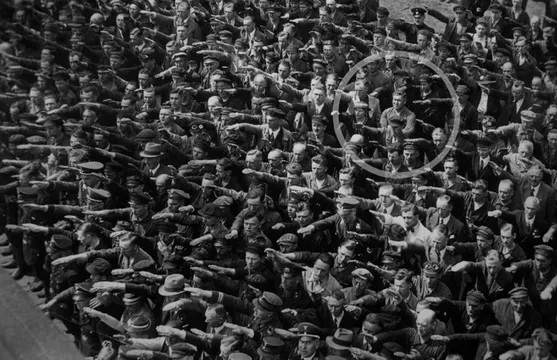Week 13: Conformity and Resistance

Seminar Questions:
- Was the Nazi regime totalitarian? If so, how?
- How did the Nazis organize the persecution of those whom they considered dangerous? what were the concentration camps? What was the Gestapo and the SS?
- How important was the consent and co-operation of ordinary Germans to the Nazi regime?
- What forms could resistance take? how can we conceptualize "resistance"?
Reading List:
Required Reading:
- R. Gellately, ‘The Gestapo and German Society: Political Denunciation in the Gestapo Case Files’, The Journal of Modern History, Vol. 60, No. 4 (Dec 1988), pp. 654-694.
- Dick Geary, 'Coercion, Consent, and Accommodation in the Third Reich' in Daniela Baratieri, Mark Edele, and Giuseppe Finaldi (eds.), Totalitarian dictatorship: new histories (Routledge, 2014)
Primary Sources:
- The Führer’s Decree on the Institution of a Chief of the German Police and the Appointment of Reichsführer SS Heinrich Himmler to the Post (June 17, 1936)
- Decree from the Head of the Security Police to the Heads of all State Police Offices (September 3, 1939)
- Pastor Dietrich Bonhoeffer, "Who Can Resist Temptation?" (December 1942)
- SD Report to the Party Chancellery on "Basic Questions Regarding the Mood and Attitude of the German People" (November 29, 1943)
Further Reading:
- Hans Mommsen, Alternatives to Hitler: German Resistance under the Third Reich (2003), Chapter 2.
- Vesna Drapac; Gareth Pritchard, Resistance and Collaboration in Hitler's Empire (Palgrave, 2017)
- Christopher Dillon, Dachau and the SS : a schooling in violence (OUP, 2015)
- Richard J. Evans, The Third Reich in Power (2005)
- Daniel Fraenkel, "The German “Righteous Among the Nations:” An Historical Appraisal,"Leo Baeck Institute Yearbook (2003) 48 (1), pp. 223-247.
- Robert Gellately, The Gestapo and German society: Enforcing racial policy 1933-1945 (Oxford: Clarendon Press, 1990).
- Robert Gerwarth, Hitler’s Hangman: The Life of Heydrich (OUP, 2012)
- Michael Geyer and John Boyer (eds), ‘Introduction’, Resistance Against the Third Reich (Univ. of Chicago Press, 1994).
- Ian Kershaw, Popular Opinion and Political Dissent in the Third Reich: Bavaria 1933-1945 (Clarendon, 1983).
- __________, Luck of the Devil The Story of Operation Valkyrie, (London: Penguin Books, 2009)
- __________, ed., Hitler, the Germans, and the Final Solution (New Haven : Yale University Press, 2008).
- Peter Longerich, Heinrich Himmler: A Life (Oxford: Oxford University Press, 2012)
- Frank McDonough, The Gestapo: The Myth and Reality of Hitler's Secret Police (Coronet, 2015)
- Tim Mason, ‘The Workers' Opposition in Nazi Germany’, History Workshop Journal, Vol. 11 (1981), pp. 120-137.
- Hans Mommsen, ‘20 July 1944 and the German Labour Movement’, in Mommsen (ed.), From Weimar to Auschwitz (Polity Press, 1991), pp. 189-207.
- Klaus-Michael Mallmann and Gerhard Paul, ‘Omniscient, Omnipotent, Omnipresent? Gestapo, Society and Resistance’, in D. Crew (ed.), Nazism and German Society (1994), pp. 166-89.
- Alison Owings, Frauen: German women recall the Third Reich (New Brunswick, N.J. : Rutgers University Press, 1993)
- Detlev Peukert, Inside Nazi Germany: Conformity, Opposition and Racism in Everyday Life (Penguin, 1989), pp. 49-66 and 145-74. Classic!
- Anne Nelson, Red Orchestra: The Story of the Berlin Underground and the Circle of Friends who Resisted Hitler (Random House, 2009)
- Eric Rentschler, The Ministry of Illusion: Nazi Cinema and Its Afterlife (Harvard UP, 1996)
- Cioma Schoenhaus, The Forger: An Extraordinary Story of Survival in Wartime Berlin (Cambridge: Da Capo, 2007): page-turning memoir with slight exaggerations of a young German Jew who forged IDs for Jews in hiding and when nearly caught, biked from Berlin to the Swiss border and climber over...
- Richard Steigmann-Gall, "Religion and the Churches" in Jane Caplan (ed.), Nazi Germany (Oxford: OUP, 2008), pp. 146-167
- Nikolaus Wachsmann, Hitler's prisons: Legal terror in Nazi Germany (New Haven: Yale University Press, 2004)
- __________________, KL: A History of the Nazi Concentration Camps (Little, Brown, 2015)
- Michael Wildt, An Uncompromising Generation: The Nazi leadership of the Reich Security Main Office (Madison: University of Wisconsin Press, 2009).
- David G. Williamson, The Third Reich, 4th Edition (2013), Chapter 11
- Nikolaus Wachsmann, "The Policy of Exclusion: Repression in the Nazi State, 1933-1939" in Jane Caplan (ed.), Nazi Germany (OUP, 2008), pp. 122-45
